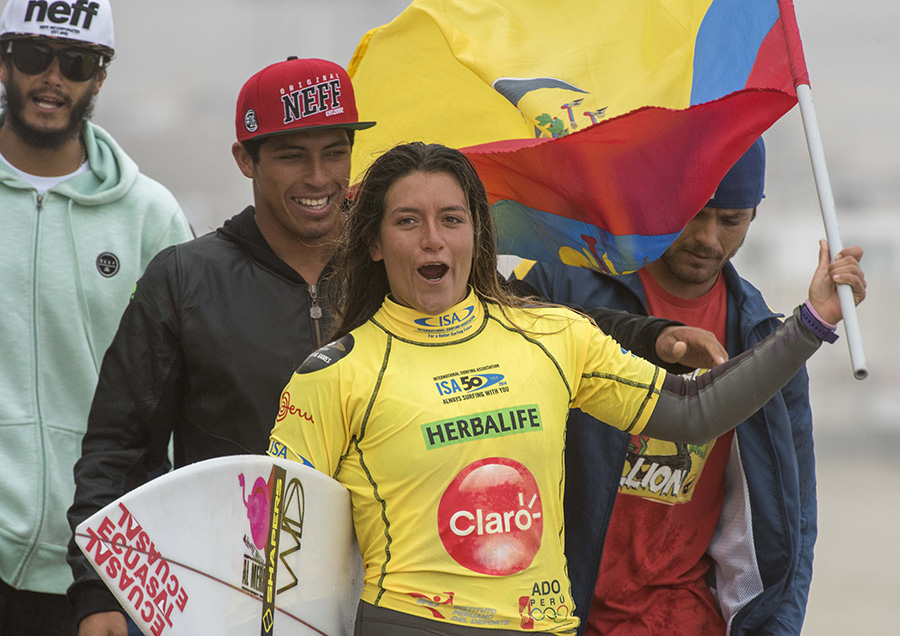Everyone can agree that everything related to surf is pretty cool. So are surf competitions. They’re fun to watch, they connect us to our surfing inspirations and it’s pretty nice to see people killing it at what they do best. But if you’re new to the world of surfing, understanding how the competition world works can be quite confusing. That is why I want to break it down for you. That way, the next time you’re watching a competition and everyone around you is talking about heats, priorities or wildcards, you will actually know what the heck they’re talking about. Let’s do it.
In the Water: Heats, Priorities and Scores – how do they work?!
Surf competitions always work more or less the same way, either it is a big international event or a national one. Basically, there are heats that a surfer needs to pass in order to move on to the next round.
A heat consists of 2 to 4 surfers at the same time in a pre-determined competition zone. Surfers have between 20 to 30 minutes (the duration of the heat depends on the type of competition) to catch the best waves possible. Every wave they catch is rated on a ten-point scale by a panel of judges and only the two best waves of each surfer is counted, giving them a score on 20. So if a surfer gets a 20/20 it would mean that he had two perfect waves and he’s doing fucking awesome 😉 But it’s not common!
>> 9-Day Surf & Yoga Trips for Women
>> Surf Inspired Workouts to do at Home
Every surfer has a lycra of a different color. When the heat starts, there is no priority which means the competitors can catch a wave with the same system of priority as a free style session. When one surfer takes his first wave, he then has second priority (if it’s a men to men heat) or fourth (if they’re 4 competitors). This means that, even if after coming back from his wave, he finds himself in the inside for the next wave, if the other competitor choose to go for it, he shouldn’t go because the first priority would be to the other one. If he goes anyway, he would receive an interference penalty (we will see that further). Also, if a surfer paddle for a wave, even if he decide not to go or if the wave is not taking him he would “loose” priority, meaning that the other would now have priority. Surfers know the order of priority by looking to the judge panel where there are some square with the same colors as their lycra and a number next to it (1 for 1st priority, 2 for 2nd priority etc.).
The surfers that get the best results get to move on to the next round. And so on, until the finals. When it’s a heat of 4 surfers, the 2 first one get to go to the next round. When it’s a men to men/women to women heat (2 surfers), the first one moves on and the second gets eliminated.
Wave Scoring
The wave scoring is done with five quality levels in mind: 0-1.9 (Poor), 2-3.9 (Fair), 4-5.9 (Average), 6-7.9 (Good), 8–10 (Excellent). The judges analyze the following major elements when they are evaluating a surfer’s wave:
1. Commitment and degree of difficulty
2. Innovative and progressive manoeuvres
3. Combination of major manoeuvres
4. Variety of manoeuvres
5. Speed, power and flow
You’ll understand that the surfers need to choose their waves wisely because it’s not about the quantity of wave they catch but the quality.
An Example of a perfect 10: Italo Ferreira during the 2018 Corona Bali Protected.
Factors judges have to consider when scoring a contest:
– Level and category or surfers – Open professionals are scored much harsher than say under 12 mini-grommets
– Type of wave – A wave like Pipeline, Hawaii will score barrels higher then, say, an air-show wave like Trestles, California.
– Quality of waves that day – A scale has to be determined based on what is possible according to the waves that particular day.
– Individual heats – Since ocean conditions are constantly changing the scale has to be adjusted for each heat.
– Length of each heat – What can be achieved in a set limited time frame.
Dropping-in, Interference and Tactics
If ever a surfer drops in on someone (there’s an other surfer catching the wave on the inside or the other one has priority and he goes anyway), the judges take away half of the points of its second best wave. We call that “interference”. Sometimes, the surfer that is losing the heat can try to make his rival do an interference in order to make him lose points. Surf contests are a dice game. The best surfer doesn’t always come out with the trophy because there are too many variables at stake. There’s a lot of heat tactics that surfers can use so it’s not just about being a good surfer, they also need to be super competitive!
The WSL (WCT + WQS)
The main surf competitions are organized by the World Surf League (WSL). Surfers that are part of this organization are competing for money prizes.
There are two circuits: the World Qualifying Series (WQS), which is where the majority of the pro surfers compete and their goal is to make the most points possible to try to enter the elite circuit; the World Championship Tour (WCT).
The WCT is the highest-level circuit; think competitors like Kelly Slater, Julian Wilson, Filipe Toledo, Stephanie Gilmore, Coco Ho, Carissa Moore… just to name a few. Basically, the goal is to get the best ranking position at the end of the year to win a spot into the WCT or for a surfer that is already part of it, to make sure he stays in it.
See current rankings for the WCT and WQS here.
 Current world no. 1. Gabriel Medina & Stephanie Gilmore. Source: WSL- Kelly Cestari
Current world no. 1. Gabriel Medina & Stephanie Gilmore. Source: WSL- Kelly Cestari
The World Qualifying Series (WQS)
Each year, there’s a competition calendar (which is more or less the same every year) and so the competitors can decide which events to attempt depending which ones they can attend. Obviously injuries, commitments or financial restraints can play a part in which events an athlete can travel to, leaving athletes at a disadvantage, as Caitlin Creeper reported in a previous article.
At every WQS competition, competitors gain points depending on how good they did. The further they go in the competition, the more points -and consequently, money- they will be making.
The WQS are divided in different point systems; some competitions give more points than others but are obviously more difficult to enter. Any surfer that pays his or her membership of the WSL and their inscription could compete to the QS 1000 and 1500.
Once you start making enough points in those events, you can compete in the QS 3000.
Then, if you have enough points, you can do the QS 6000 and finally if you’re doing good enough you can enter the prime events of 10 000.
You’ll have guessed that the numbers are due to the amount of points that the winner gets and so the more points you can gain, “the more level there is”.
So let’s say a surfer wins a QS 10 000, he’ll get a much better ranking than the one winning a QS 1000.
At the end of the year, each QS surfer gets ranked based on his best 5 results throughout the year.
In the men’s division:
The top 10 surfers on the QS get to enter the WCT.
In the women’s division:
The top 6 surfers of the QS get to enter the Championship Tour.
The World Championship Tour (WCT)
In the Championship Tour (CT), there are 34 surfers in the men’s division and 17 in the women’s, including the wildcards.
Wildcard: surfers who are chosen to compete alongside the CT surfers in a single CT event. Typically candidates for the event wildcard will come from the event sponsor’s team, the local area, or both. Not only do these surfers complete the seed list and/or fill in for injured surfers, but they also bring exciting new faces and challenges to the CT elite.
Just like the WQS, the goal of the CT surfer is to make enough points to keep his/her spot on the tour for the next year. All CT competitions are worth the same: 10 000 points which means that the winner is summing 10 000 points. The 2nd place would have 7800 points, the 3rd place, 6085, etc.
In the men’s division, there’s 11 events throughout the year and the best 9 results are combined to equal their final point total.
In the women’s division, there’s 10 events and they sum the best 8 results to equal their final point total.
Who enters the CT ?!
In the men’s division:
- The 22 highest-ranking surfers of the CT get to stay in the Championship Tour.
- As said previously, the top 10 QS surfers get to enter the CT (not including surfers qualifying in the Top 22 on the WSL Men’s CT rankings).
- 2 wildcards per competition
- Total: 34 surfers
In the women’s division:
- The 10 highest-ranked on the CT tour stay in the CT.
- As said previously, the top 6 surfers of the QS get to enter the CT (not including surfers qualifying in the Top 10 on the WSL Women’s CT rankings).
- 1 wildcard per competition
- Total: 17 surfers
The International Surfing Association (ISA)
There are also competitions organized by the International Surfing Association (ISA) that aren’t for money prizes but for medals for the country. For example, the World Surfing games is a competition that take place every year in a different country (this year it is going to be in Miyazaki, Japan from September 7th to 15th, 2019). Each country that is part of the ISA association can send a team and the surfers are competing for their country. It used to be a team of 4 men and 2 women but the ISA recently announced that in order to offer equal competition slots for men and women, the teams will for now on be formed by 3 men and 3 women. This decision has been made in line with the new entry of surfing in the Olympics and its commitment to gender equality. Although there are no money prize in those competitions, this is a good opportunity for surfers to get known and get sponsored.
With this fresh information in mind, you can now follow your favourite surfers as big league events are always being broadcasted live online !… only this time with some actual clue what the frick is going on. 🙂
>> 9-Day Surf & Yoga Trips for Women
>> Surf Inspired Workouts to do at Home
![]()














